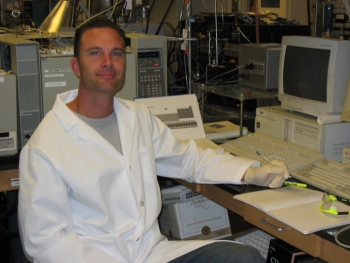
School:
Grade Level:
Teaching Position:
Supervisor:
Department:
Mentor:
Research Project Year:
Research Project Title:
Research Project Description:
Lanthanum Fluoride (LaF3) was used as a host material for the synthesis of nanoparticles doped with Lanthanides and related capping agents in order to synthesized new materials for LED white lighting. The LaF3 was synthesized in solution at temperatures ranging from 60°-75°C for times ranging between 2 and 20 hours. Formed precipitates were dried and pulverized into a powder, and subsequently analyzed and characterized by X-Ray Diffraction (XRD), Photoluminescence Spectrometry (PL), and Transmission Electron Microscopy (TEM). Dopants included Europium (as Eu(NO3)3) and Cerium (Ce(NO3)3). The capping agent used was Polyvinyl Alcohol (PVA). Compounds synthesized showed weak fluorescence under a UV Lamp and only weak identifying peaks on the PL Spectrometer. XRD results showed a good match for LaF3 and wide peaks were good initial identifiers that nanoparticles had been synthesized.
TEM analysis showed both elongated and spherical nanoparticles in the size range of 10-20 nm. Amorphous and agglomerated particles were also observed. A possible explanation for the poor luminescent qualities of the materials is the existence of the amorphous particles. It is unlikely that much capping took place, as the results with the capping agent PVA did not demonstrate an improvement in size and shape distribution of the nanoparticles. Spectrometer analysis imbedded with the TEM did confirm the likelihood of doping. Further work should include the use of higher temperatures and longer heating periods during the synthesis phase in order to improve the doping process and for the improvement of luminescent properties.
Research Project Attachments:
| Attachment | Size |
|---|---|
| 1.43 MB |
Curriculum Project Year:
Curriculum Project Title:
Curriculum Project Description:
My curriculum project is a sub-unit interleaved with an introductory Chemistry (or Physical Science) Unit at the High School Level. Along with support activities used to help students in negotiating elementary chemistry with an emphasis on decoding article from scientific journals and applying that understanding to a culminating group activity which includes a final poster project. Included in the project is a short lab examining materials with fluorescent properties when exposed to UV light and looking at real world applications with these materials with regards to LED lighting.
Curriculum Project Attachments:
| Attachment | Size |
|---|---|
| 1.28 MB | |
| 1.61 MB |
